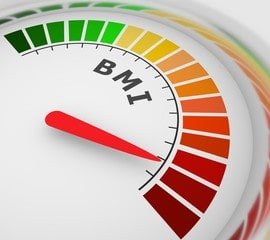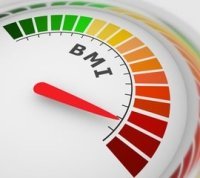BMI Calculator


Updated January 23, 2024
Use the below interactive BMI calculator, also known as the body mass index calculator, to find out what weight status you fall into. Based
on the results of the your weight status will either be underweight, normal, overweight or obese.
BMI is measure of body fat based on your height and weight. This applies to both adult men and women. BMI does not differentiate between body fat and muscle mass.
If you are a body builder or have a lot of muscle bulk you will have a higher BMI but would not be considered overweight or obese even if the calculator indicates this.
BMI Calculator Results - What's it for?
BMI is used as a screening tool to identify potential health risks related to weight concerns. The body mass index calculation uses a person's weight and height. It does not differentiate between genders, so men and women will use the same calculation.
It will show results into one of four classes;
- Under 18.5 = Underweight
- Between 18.5 - 24.9 = Normal
- Between 25 - 30 = Overweight
- Over 30 = Obese
These classes are further broken down into categories.
Body Mass Index Categories
The four classes help indicate where you stand with your weight compared to your height. This is a good indication if there are potential health issues due to your weight.
The four classes have the following health risks;
Class |
BMI |
Health Risk |
| Underweight | < 18.5 | Moderate |
| Normal | 18.5 - 24.9 | Minimal |
| Overweight | 25 - 30 | Moderate |
| Obese | > 30 | High |
Depending on what category you are at within a class, this risk could go up. For instance, if your BMI is under 16, this would be in the severe underweight class. This could increase any health risks due to the low body weight.
This is true for those in the obese class. If they had a BMI of over 40, this puts them in the Obese III category, increasing health related issues.
BMI Calculator Explainded
The BMI (Body Mass Index) calculation is used as a screening tool to help medical personnel gage if there is a health risk due to your weight. This is not the only tool used as some people will fall into a higher risk category that are not potentially at risk


Based on their body size, fat percent and family history, a person may fall into the overweight category but are in fact at a healthy weight for them. For example, a person with very little body fat and a larger percent of lean muscles may weigh more than what is in the guidelines for their gender and height.
The Body Mass Index calculation will only show potential excess body fat and weight problems.
An evaluation of your diet, family history and activity level will also help measure your risk of weight related diseases.
BMI Caluclator and Body Mass Index Definition
In order to understand the results of the BMI calculation you need to understand BMI. The definition of Body Mass Index is a number from the results of a calculation using a person’s weight and height.
The results of the BMI formula are used as a tool to screen a person for potential weight problems due to body fat. Excess weight and body fat could put a person at risk for certain diseases such as high blood pressure, high cholesterol and type 2 diabetes just to name a few.
The BMI calculator results will fall into one of four weight status categories; underweight, normal, overweight and obese. This status is used as an indicator of body fat.
Although the BMI calculator does not measure the percent of body fat, research shows that the Body Mass Index results have a direct correlation to body fat percent. The results will only show potential excess body fat and weight problems.


Additional tests and evaluations would also have to be performed to be certain. Based on the results, your doctor may run additional tests such as a skin fold test to help measure the percentage of body fat. Additionally, your doctor may evaluate your diet, family history and activity levels as well as to measure your risk of weight related diseases.
Knowing the BMI Formula
Body Mass Index is calculated the same for adults and children. The results for adults however are not gender specific whereas the results for children and teens is age and gender specific.
For children and teens, the calculation is the same as below, but the results are interpreted using the age and gender percentiles.
BMI CalculationPounds and inches
weight (lb) / [height (in)]² x 703
Example: Weight = 175 lbs - Height = 5' 6" (66 inches), Calculation = 175 / (66)² x 703 = 28.24
Kilograms & Meters
Weight (kg) / height (m)² Note: Since height is generally measured in centimeters, divide height in cm by 100 to get the measurement in meters
Example weight = 80 kg - height = 168 cm (1.68 m), Calculation = 80 / (1.68)² = 28.34
The results will fall into one of 4 categories. These are;
Class |
BMI |
Health Risk |
| Underweight | < 18.5 | Moderate |
| Normal | 18.5 - 24.9 | Minimal |
| Overweight | 25 - 30 | Moderate |
| Obese | > 30 | High |
Within each class, there is a further break down by category. Below is an outline of the categories within the classes.
Class |
Category |
BMI |
Health Risk |
| Underweight | Severe Underweight | < 16 | Moderate |
| Moderate Underweight | 16 - 16.99 | Moderate | |
| Underweight | 17 - 18.49 | Moderate | |
| Normal | Normal | 18.5 - 24.9 | Minimal |
| Overweight | Overweight | 25 - 26 | Low |
| Moderately Overweight | 27 - 29 | Moderate | |
| Obese | Obese | 30 - 34 | High |
| Severe Obese | 35 - 39 | Very High | |
| Morbid Obese | 40 + | Extremely High |
Based on the results, your doctor may suggest some changes in diet and exercise. If you find yourself within the normal range of the BMI results but still feel you want to lose or tone, then focus first on exercising and eating healthier. Don't try to cut calories to lose weight but instead focus on losing inches and toning muscles.
However if your results are in the overweight or obese category, then first check with your doctor to see if additional tests should be run. Also you will want to create a weight loss plan to lose weight and body fat. Your plan should include eating healthy and exercising.
In addition to this free online BMI Calculator, check out the BMR calculator as well.
Additional Articles
Exercise Motivation
If you want to lose weight and body fat, then exercising will help. Use these tips to get motivated and start working out today.
Eating Healthy
Use these tips to start eating healthier so you can lose the weight. Selecting healthier foods not only helps with weight loss, but can
reduce the risk of certain medical conditions.
Weight
Loss Support Groups
If you are struggling to lose the weight, then perhaps a support group
can help. Check out this article to learn more about the types of groups and
select the one that works with your lifestyle.
